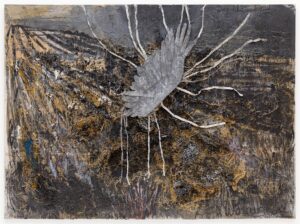Anselm Kiefer
German
1945, Donaueschingen, Germany
Anselm Kiefer grew up in postwar West Germany amid the rubble of World War II. His newly divided country was in a state of identity crisis, lacking foundational myths or symbols untainted by the Nazis' pathological nationalism. Kiefer initially studied law to learn about codes of human behavior, fully intending to become an artist. By the 1970s, he began to develop his best-known works: massive, heavily encrusted paintings of shattered landscapes devoid of people. His art draws upon a range of traditions —including ancient Egyptian mythology, biblical stories, Jewish mysticism, and modern astronomy — in the attempt to construct a new symbolic system with broad human relevance. Kiefer is currently active in the south of France, where he has lived since 1993.
Audio Stories
What does Germany’s troubled history mean for Kiefer?
transcripts
Español
普通话
Works in the Collection
-
 Anselm KieferDem unbekannten Maler (To the Unknown Painter)
Anselm KieferDem unbekannten Maler (To the Unknown Painter) -
Anselm KieferDie Frauen der Revolution (Women of the Revolution)
-
 Anselm KieferSulamith
Anselm KieferSulamith -
 Anselm KieferDer Rhein (The Rhine)
Anselm KieferDer Rhein (The Rhine) -
 Anselm KieferDie Meistersinger (The Mastersingers)
Anselm KieferDie Meistersinger (The Mastersingers) -
 Anselm KieferMargarethe
Anselm KieferMargarethe -
 Anselm KieferWege der Weltweisheit: die Hermannsschlacht (Ways of Worldly Wisdom: Arminius's Battle)
Anselm KieferWege der Weltweisheit: die Hermannsschlacht (Ways of Worldly Wisdom: Arminius's Battle) -
 Anselm KieferUnternehmen Seelöwe (Operation Sea Lion)
Anselm KieferUnternehmen Seelöwe (Operation Sea Lion) -
 Anselm KieferWölundlied (Wayland's Song)
Anselm KieferWölundlied (Wayland's Song) -
 Anselm KieferWege: märkischer Sand (Ways: March Sand)
Anselm KieferWege: märkischer Sand (Ways: March Sand) -
 Anselm KieferDas Museum (The Museum)
Anselm KieferDas Museum (The Museum) -
 Anselm KieferMaria durch den Dornwald ging (When Mary Went Through the Thorn-Forest)
Anselm KieferMaria durch den Dornwald ging (When Mary Went Through the Thorn-Forest) -
 Anselm KieferDaath
Anselm KieferDaath -
 Anselm KieferEuphrat/Tigris
Anselm KieferEuphrat/Tigris -
 Anselm KieferEntfaltung der Sefirot (Unfolding of the Sephirot)
Anselm KieferEntfaltung der Sefirot (Unfolding of the Sephirot) -
 Anselm KieferMelancholia
Anselm KieferMelancholia -
Anselm KieferUnternehmen Seelöwe (Operation Sea Lion)
-
 Anselm KieferSeraphim
Anselm KieferSeraphim -
 Anselm KieferDie Sechste Posaune (The Sixth Trumpet)
Anselm KieferDie Sechste Posaune (The Sixth Trumpet) -
 Anselm KieferDie Geburt der Sonne (The Birth of the Sun)
Anselm KieferDie Geburt der Sonne (The Birth of the Sun)
Please note that artwork locations are subject to change, and not all works are on view at all times.
Only a portion of SFMOMA's collection is currently online, and the information presented here is subject to revision. Please contact us at collections@sfmoma.org to verify collection holdings and artwork information. If you are interested in receiving a high resolution image of an artwork for educational, scholarly, or publication purposes, please contact us at copyright@sfmoma.org.
This resource is for educational use and its contents may not be reproduced without permission. Please review our Terms of Use for more information.